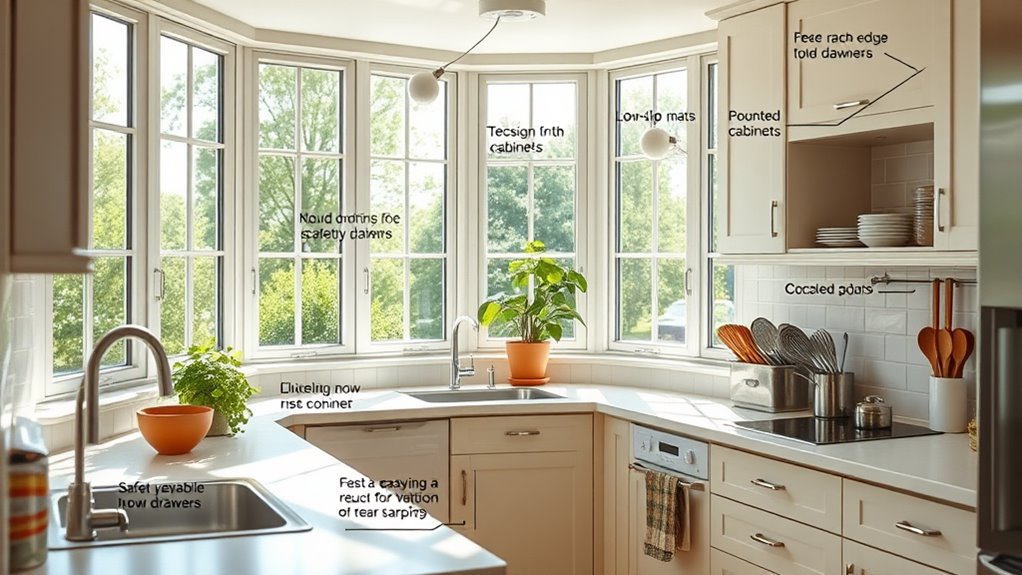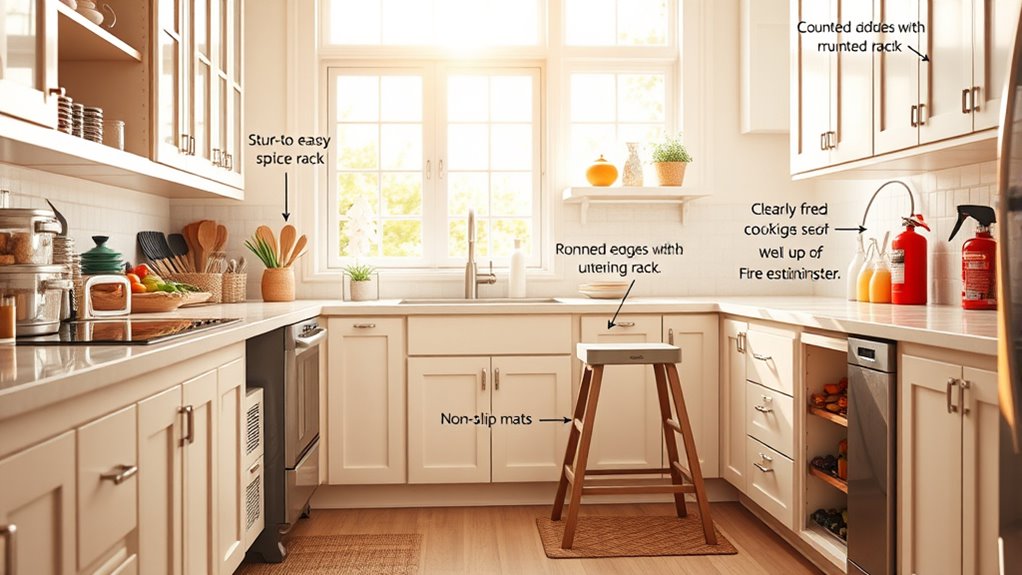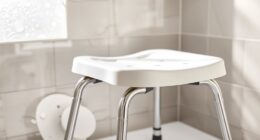To create a safe, accessible kitchen for seniors, incorporate ergonomic tools like jar openers and lever faucets to reduce strain. Use bright, contrasting colors for decor and organization to improve visibility and prevent accidents. Keep frequently used items within easy reach at waist level, and label containers with bold, contrasting labels. Install good lighting and add non-slip mats to prevent slips and falls. Maintaining a clutter-free space with open shelves or transparent containers boosts safety and confidence—exploring these tips further will help you craft the perfect senior-friendly kitchen.
Key Takeaways
- Use bright, contrasting colors for walls, cabinets, and organization to enhance visibility and reduce accidents.
- Incorporate adaptive gadgets like jar openers and ergonomic tools to minimize strain and improve safety.
- Keep frequently used items at waist level with clear containers and bold labels for quick, easy access.
- Ensure proper lighting over work areas and add non-slip mats to prevent slips, falls, and burns.
- Maintain clutter-free surfaces with open shelving and transparent storage to promote a tidy, accessible cooking space.

Creating a safe and functional kitchen is essential for seniors who want to cook comfortably and confidently. When designing your space, consider incorporating adaptive gadgets that are specifically made for ease of use. These tools can include jar openers, ergonomic knives, or lever-style faucets, all designed to reduce strain and improve safety. Adaptive gadgets are a game-changer because they help you maintain independence and make everyday tasks simpler. Equally important is the use of color contrast in your kitchen decor and organization. Bright, contrasting colors on countertops, cabinets, and appliances can markedly improve visibility, making it easier to distinguish between different surfaces and objects. For example, choosing a dark countertop with light-colored cabinetry or vice versa creates a stark contrast that helps you identify edges and items more clearly. This simple change can prevent accidental spills or mishandling of hot items, reducing the risk of falls or burns.
When organizing your kitchen, keep frequently used items within easy reach to minimize bending or stretching. Place everyday essentials such as utensils, spices, and dishware on open shelves or in accessible drawers at waist level. Use clear containers for pantry items so you can quickly identify contents, and label shelves with large, bold fonts for easy reading. Incorporating color contrast into these labels and containers further enhances visibility, especially if you have vision challenges. To improve safety, install good lighting throughout your kitchen, especially over work areas. Bright, well-placed lights combined with contrasting colors help you see what you’re doing and prevent accidents. Also, consider adding non-slip mats or rugs in high-traffic areas to prevent slips and falls, especially if your balance isn’t as steady as it used to be.
In terms of decor, opt for simple, uncluttered surfaces that avoid visual chaos. A tidy kitchen with well-organized zones makes cooking less stressful and easier to manage. Use open shelving or transparent storage to keep things accessible and visible, reducing the need to search through closed cabinets. When selecting decor items, choose those with bold, contrasting colors to add vibrancy and aid visibility. Keep countertops clear of unnecessary items to avoid clutter that can cause accidents or hinder movement. Overall, combining adaptive gadgets with strategic use of color contrast creates a safer, more accessible environment. These adjustments not only help you cook more confidently but also make the space more enjoyable to spend time in. Remember, small changes can have a big impact on your independence and safety in the kitchen, so prioritize practicality and clarity in your decor and organization choices. Additionally, exploring unique and wicked planters can inspire creative ways to incorporate functional decor that is both attractive and accessible.
Frequently Asked Questions
How Can I Make My Kitchen More Accessible for Seniors With Mobility Issues?
To make your kitchen more accessible for seniors with mobility issues, consider implementing universal design principles. You can install lower countertops and open space for easy movement, and add assistive devices like grab bars and pull-out shelves. These modifications help seniors navigate safely and independently. By creating a space that prioritizes safety and convenience, you guarantee your kitchen remains functional and welcoming for everyone, regardless of mobility challenges.
What Are the Best Non-Slip Flooring Options for Elderly-Friendly Kitchens?
Think of your kitchen as a ship that needs a sturdy deck. You should choose the best non-slip flooring options like slip resistant tiles or non-slip mats. These guarantee safety by reducing fall risks. Opt for textured surfaces that grip underfoot, making movement secure. By prioritizing slip-resistant tiles and adding non-slip mats, you create a safer environment where seniors can cook confidently and comfortably.
How Do I Choose Ergonomic Kitchen Tools for Seniors?
When choosing ergonomic kitchen tools for seniors, focus on those with ergonomic handles that reduce strain and improve grip. Opt for lightweight tools to make cooking easier and less tiring. Look for designs that fit comfortably in their hands, with non-slip grips for added safety. By selecting tools with these features, you help seniors cook more independently and safely, enhancing their overall kitchen experience.
What Lighting Improvements Help Prevent Accidents in Senior Kitchens?
Imagine a kitchen where every corner is gently illuminated, guiding your steps like a trusted friend. You should add under cabinet lighting to brighten work surfaces and reduce shadows, making chopping safer. Installing motion activated lights ensures the space lights up as you enter, preventing accidental trips. These enhancements create a well-lit environment, boosting safety and confidence, so you can focus on cooking and enjoying your time in the kitchen.
Are There Specific Safety Features I Should Add to Stove and Oven Controls?
You should consider adding smart stove controls and oven safety features to enhance safety. Smart stove controls allow you to easily turn off appliances remotely or set timers, reducing the risk of accidents. Oven safety features like automatic shut-off, child locks, and temperature alerts help prevent burns and fires. These upgrades make cooking safer and give you peace of mind, especially if you or a loved one are managing kitchen safety.
Conclusion
Creating a safe, organized kitchen not only makes cooking easier but also reduces the risk of accidents. Did you know that falls are the leading cause of injury among seniors, often happening in the kitchen? By applying these decor and organization tips, you can make your space safer and more comfortable. Remember, a well-designed kitchen encourages independence and confidence while cooking, helping you enjoy your time in the kitchen safely and comfortably every day.









